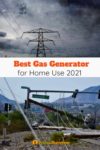[ad_1]
Gas generators are a low-cost, reliable source of backup power. There are plenty on the market, making it time-consuming to research different models and work out which one is right for you.
The good news is, you can skip the hard work.
We’ve researched the best gas generators on the market and put together a detailed buyer’s guide with everything you need to know about buying a gas generator for home use.
Whatever your budget or power requirements, there’s a model in this list for you.
Gas Generator Reviews
Best for Home Use
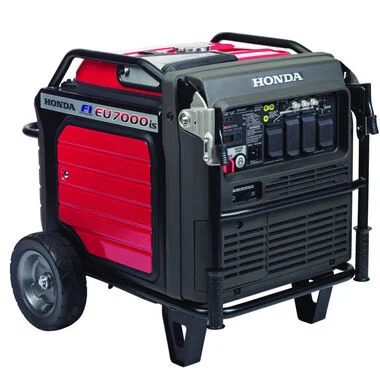
Honda Inverter Generator Gas 389cc 7000W with CO Minder EU7000ISNAN
Honda is one of the most well-regarded generator brands and with good reason. If you’re happy to spend money to get the best quality and reliability, then they’ll be top of your list.
The EU7000iS is one of their largest models, offering 5,500 watts of continuous power with a generous 7,000 watts maximum power. It’s an inverter generator that produces “clean” power, akin to running your appliances off mains electricity. This may be particularly important if you have a lot of sensitive electronics.
Inverter generators are quieter than conventional models. Despite its size, the EU7000iS produces just 58 dBA of noise when fully loaded.
Read more about keeping a generator quiet.
It’s also highly efficient, running for up to 18 hours on a single tank of fuel. Part of this is down to the electronic fuel injection system, which eliminates the engine choke and reduces problems that can typically occur with the carburetor, minimizing maintenance.
The generator includes Honda’s CO-MINDER technology, which monitors carbon monoxide levels and automatically shuts down the generator before levels get dangerously high.
Read more about CO detectors.
It has a push-button electric start that can also be triggered remotely using the Honda My Generator App.
In summary, the EU7000iS has pretty much everything you want in a generator.
The downside?
This impressive list of features comes at a price. At 261 pounds, it’s also heavy, though it does come with a wheel kit and fold-down handles to help you move it around.
Max Power:
7000W
Continuous Power:
5500W
Weight:
261 lbs
Runtime:
6.5 hours (full load), 18 hours (quarter load)
Tank Size:
5.1 gallons
- Stable, clean power
- Fuel efficient
- Carbon monoxide detection system
- Quiet
- Reliable with low maintenance
Best Value
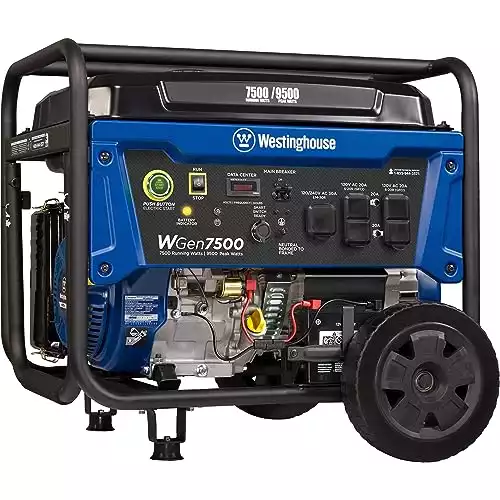
Westinghouse WGen7500
If your budget doesn’t stretch to the Honda, then the Westinghouse WGen 7500 is an excellent alternative. It may not have the Honda’s premium features or reliability, but it delivers more power than the EU7000iS for a hell of a lot less dollars.
The 6.6-gallon tank gives you a running time of around 11 hours on half load. At its rated load, the 7500-watt output is enough to power your kitchen appliances plus a water heater or air conditioning unit.
The L14-30R 30A 120/240V twist-lock outlet enables you to connect the generator to a transfer switch. There’s also an outlet to connect to a Westinghouse ST Switch – a DIY alternative to a transfer switch or interlock device.
There’s an electric start button in addition to the recoil cord, and the remote key fob is a nice touch, enabling you to turn the generator on and off from the comfort of your home.
At 72dBA, it’s significantly noisier than the Honda, and though it’s a bit lighter, it’s still no picnic to move around. But you may feel that these are reasonable compromises for the extra dollars in your pocket.
Max Power:
9500W
Continuous Power:
7500W
Weight:
192 lbs
Runtime:
11 hours at 50% load
Tank Size:
6.6 gallons
- Affordable and powerful
- Reasonable runtime
- Remote electric start
- CARB compliant
Best for Heavy Users
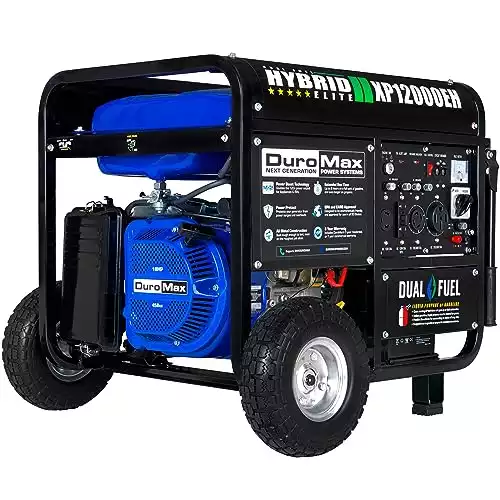
DuroMax XP12000EH Generator
If you need to keep a power-hungry house running when the lights go out, then DuroMax’s range of high-powered generators should be your first port of call.
The XP12000E isn’t the biggest in the range, but it’s a good deal less expensive than the 15,000-watt XP15000E, and for most households, the 9,500 watts of running power it provides will be more than sufficient.
There are many connection options, including a 120V/240V 50A outlet and a 12V DC outlet for charging batteries. You can also operate the generator at both 120V and 240V simultaneously, making this the most versatile of the generators we’ve reviewed.
At 217 pounds, it’s weighty but still not as heavy as the Honda EU7000iS. A wheel kit is included, but there have been reports of the wheels flattening over time. It’s noisy (74 dBA), but given the generator’s size, that’s to be expected.
Max Power:
1200W
Continuous Power:
9500W
Weight:
217 lbs
Runtime:
9 hours at 50% load
Tank Size:
8.3 gallons
- Very powerful
- Multiple outlets including 50A and DC
- Good value for money
- CARB compliant
Best Budget Option
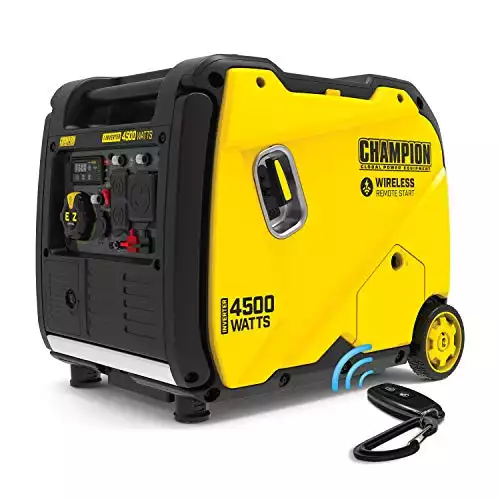
Champion 4500-Watt Generator
The Champion 4500 Watt Portable Generator is on the small side for home use. However, if you don’t need to run water heaters, pumps, or air conditioning units, then it may be sufficient for emergency power use.
As a guide, you should be able to use it to run a refrigerator, freezer, laptop charger, and either an electric stove or washing machine.
There’s a limited range of output points: a 30-amp/120-Volt twist lock, 30-amp/120-Volt RV connection, and two 20-amp/12-Volt outputs. As there’s no 240-Volt output, you won’t be able to connect it to a transfer switch.
The generator has a running time of nine hours at half load, and the built-in Intelligauge monitors the power output and helps you track maintenance intervals.
At under 100 pounds, it’s one of the lightest generators we’ve reviewed.
We’d recommend this generator for preppers on a budget or people wanting a compromise between portability and power.
This generator is CARB compliant.
Max Power:
4500W
Continuous Power:
3500W
Weight:
90 lbs
Runtime:
14hr at 25% load
Tank Size:
2.3 Gallon
- Great value for money
- CARB-compliant
- Lighter than other generators
- Good choice for small households
Best Quiet Option
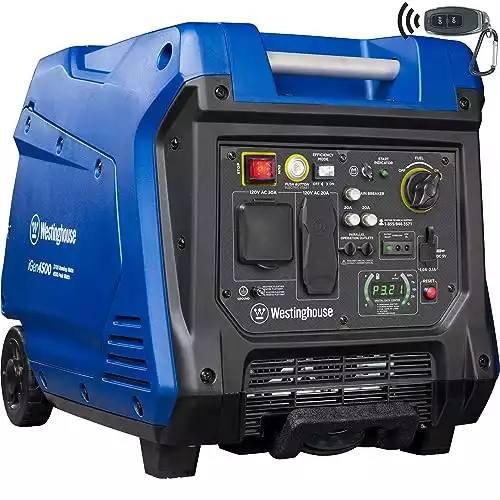
Westinghouse iGen4500
The iGen4500 is a large, surprisingly affordable inverter generator. You may struggle to run your whole house off it, but it’s worth considering if you have multiple laptops, televisions, cell phones, and other sensitive electronics.
If you combine it with the Westinghouse WGen 7500, you’d have the power and the sensitivity you need at a much lower price than the Honda EU7000iS.
That said, the iGen4500 isn’t quite comparable to the EU7000iS. It’s less powerful and doesn’t have the carbon monoxide safety system that more expensive brands build into their generators. But the run time and the noise level (as low as 52dBa) are comparable.
The other surprising thing about the iGen4500 is its weight. At 98 pounds, it is light enough for one person to transport, and it comes with wheels attached.
There’s a lot to like about this generator, but it won’t meet everyone’s needs. From customer reviews, Westinghouse’s customer service isn’t great, so this may not be the best option if you have limited experience with generators.
Max Power:
4500W
Continuous Power:
3700W
Weight:
98 lbs
Runtime:
Up to 18 hours at 25% load
Tank Size:
3.4 gallons
- Efficient generator with a long run time
- Quiet
- Relatively lightweight
- Affordable
- Poor customer service
- No 240-Volt output
Best Whole House Option
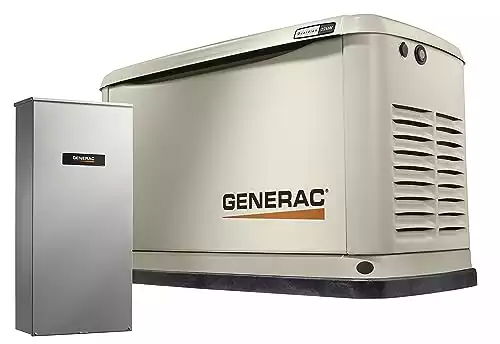
Generac 70432 Home Standby Generator
If regular power outages plague you, then you may want to consider installing a static generator that’s large enough to power your whole house. What you lose in portability, you gain in power and ease of use.
The Generac Guardian series of home generators are some of the best-regarded on the market. The 70432 can generate up to 22kW of power – enough to power an entire house.
Rather than having a self-contained fuel tank, the generator will tap into a natural gas line or gas tank. If you don’t have either of these installed, you’ll need to factor them into your cost calculations. The transfer switch also needs to be wired in by an electrician.
The beauty of this generator is that when the power goes out, it will automatically kick in to keep your home running. This makes it a good option if you suffer from regular outages or spend a lot of time out of town. No one likes returning home to a defrosted freezer full of spoiled food!
Max Power:
22,000W
Continuous Power:
22,000W
Weight:
525 lbs
Runtime:
Continuous
Tank Size:
N\A
- Can power your whole house
- No need to refuel
- Starts automatically when the power goes out
- Very expensive
- Not portable
Highly Rated
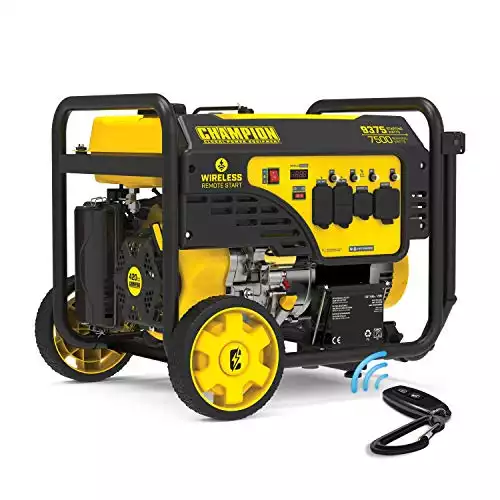
Champion 9375/7500-Watt Portable Generator
The Champion 7500 Watt generator shares many similarities with the Westinghouse WGen 7500. While the WGen 7500 had an edge in several areas – it has a longer run time and a handy remote start – the two generators are similarly priced, and many people prefer Champion for reliability and good customer service.
The Champion 7500 also has a couple of features that the Westinghouse lacks. In addition to the 30A 120/240V twist-lock outlet, there’s a 50A outlet. The model also features Champion’s Cold Start technology, making the generator easier to start in cold weather.
Both the WGen 7500 and the Champion 7500 are excellent options. Which suits you best will depend on which features you value the most.
Max Power:
9375W
Continuous Power:
7500W
Weight:
199 lbs
Runtime:
8 hours at 50% load
Tank Size:
5.7 gallons
- 50A outlet
- Cold Start technology
- CARB compliant
- No remote start option
- Heavy and noisy
Pros and Cons of Gas Generators
Before discussing what to consider when buying a gas generator, we’ll cover the pros and cons compared to propane generators, diesel generators, and dual fuel generators.
Advantages of Gas Generators
Disadvantages of Gas Generators
Buying a Gas Generator for Home Use
The first thing you need to decide when buying a gas generator for emergency power backup is whether you want a portable or static model.
Portable generators are typically smaller and less expensive. They may be your only option if you don’t have a gas pipeline or fuel tank. Static generators are often used for greater power output – they enable you to power your whole house rather than just selected circuits or appliances.
We’ve focused mainly on portable generators in this roundup but have included one whole-house model for comparison.
Power Output
You can buy portable gas generators with a peak output of 1,000 watts up to 15,000 watts. For home use, we’d recommend looking at generators with an output of 5,000 watts or more. This should allow you to run a refrigerator, sump pump, TV, microwave, and some lights.
When looking at power output, there are two numbers you need to consider:
The running (or continuous) power output is the number of watts the generator will consistently supply. When you’re totaling your home appliances’ power requirements, this is the figure you need to focus on.
However, appliances need to draw on extra power when starting up. Once you’ve calculated how much continuous power you need, check to ensure the generator has a sufficient peak output (starting watts) for your home.
Read more about what size generator you might need.
Emissions
Before buying a generator, you’ll need to check your local air quality and noise restrictions to ensure that your generator won’t be in breach of regulations. You may also need to purchase an air quality and/or noise permit depending on your generator’s size and how often it’ll be used.
The state of California has some of the strictest requirements relating to air quality. Look out for CARB-certified models to be sure your generator meets the required standard.
Size and Weight
No generator can be described as “lightweight,” but depending on how much portability you need, size and weight might factor into your buying decision. If you want to transport your generator in an emergency or live on your own, you may decide to go for a lighter, less powerful model.
Small to mid-sized generators (around 5,000 watts) typically weigh up to 100 pounds. Larger, 7,500-watt and above generators can weigh two hundred pounds or more.
Operating Noise
There’s no getting away from it – generators are noisy beasts. Even “quiet” models produce enough noise to be classed as a nuisance in close proximity.
If minimizing noise is a priority for you, look at inverter generators such as the Honda EU7000iS or Westinghouse iGen4500 and read our article on the best quiet generators.
How to Run a Gas Generator Safely
Portable generators can quickly produce life-threatening amounts of carbon monoxide. More expensive generators have a built-in safety system that shuts down the engine when high carbon monoxide levels are detected. This should be considered an emergency backup safety measure.
Follow these tips to operate a portable gas generator safely:
- Site your generator at least 20 feet from your home
- Operate it in an open space – not your garage!
- Make sure the exhaust is directed away from windows and air conditioning units
- Use a heavy-duty extension cable that’s rated for outdoor use
- Let the generator cool before refueling
- Keep on top of your maintenance
- Connect the generator to your home via a transfer switch
How to Connect a Generator to Your Home
If your generator’s purpose is to provide backup power for your home, then the safest way to connect it to your electricity network is via a transfer switch. This allows you to manually switch between mains electricity and your generator to power hardwired appliances. The other advantage of a transfer switch is that there’s only one cable connecting your home and your generator.
Transfer switches are designed to be compatible with a 220-volt input, usually only available on larger generators of 5,000 watts or more. You’ll also need to get an electrician to install it.
An interlock device is a cheaper version of a transfer switch that’s quicker to install. It covers your service panel’s main cut-off switch, so you can only power your home from either your generator or the mains.
Learn more about where to buy a generator.
[ad_2]
Source link

